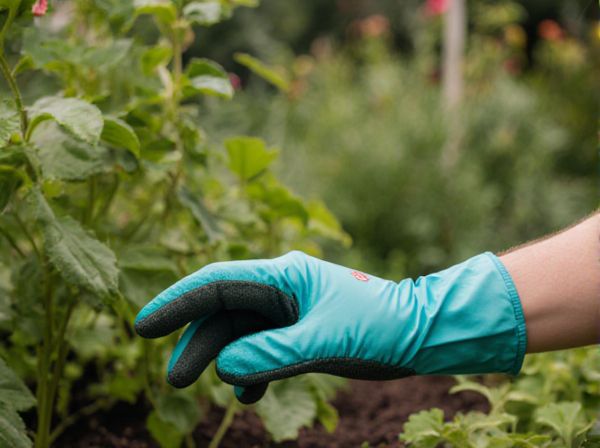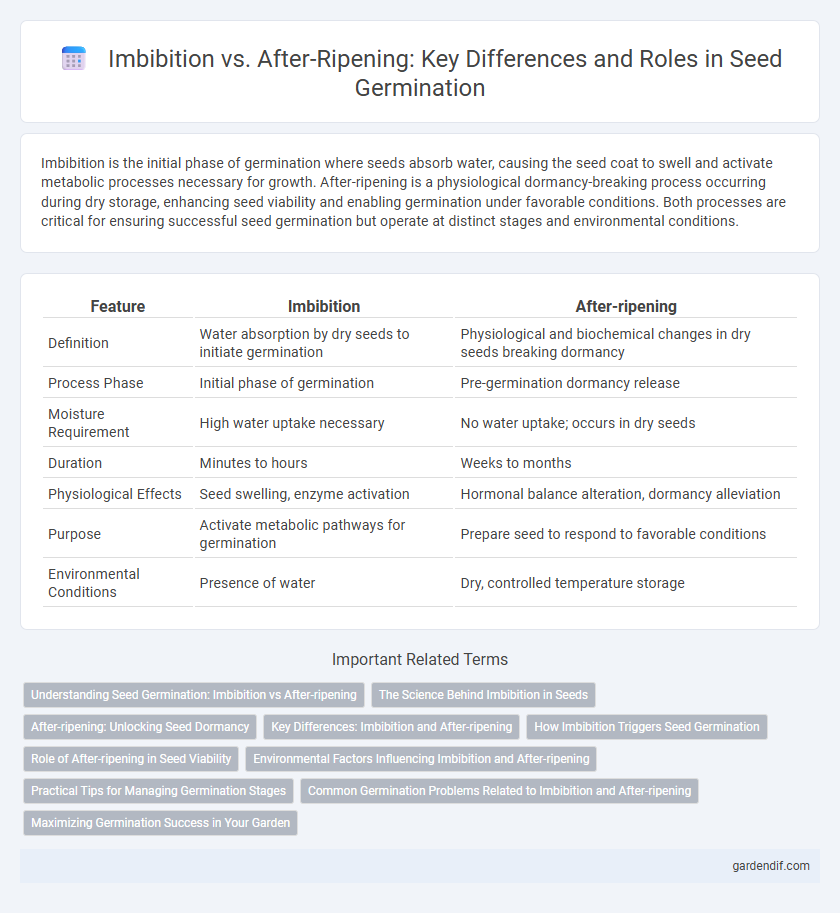
Imbibition vs After-ripening Illustration
Imbibition is the initial phase of germination where seeds absorb water, causing the seed coat to swell and activate metabolic processes necessary for growth. After-ripening is a physiological dormancy-breaking process occurring during dry storage, enhancing seed viability and enabling germination under favorable conditions. Both processes are critical for ensuring successful seed germination but operate at distinct stages and environmental conditions.
Table of Comparison
| Feature | Imbibition | After-ripening |
|---|---|---|
| Definition | Water absorption by dry seeds to initiate germination | Physiological and biochemical changes in dry seeds breaking dormancy |
| Process Phase | Initial phase of germination | Pre-germination dormancy release |
| Moisture Requirement | High water uptake necessary | No water uptake; occurs in dry seeds |
| Duration | Minutes to hours | Weeks to months |
| Physiological Effects | Seed swelling, enzyme activation | Hormonal balance alteration, dormancy alleviation |
| Purpose | Activate metabolic pathways for germination | Prepare seed to respond to favorable conditions |
| Environmental Conditions | Presence of water | Dry, controlled temperature storage |
Understanding Seed Germination: Imbibition vs After-ripening
Imbibition is the initial phase of seed germination where seeds absorb water, leading to swelling and activation of metabolic processes. After-ripening refers to a physiological process occurring in dry seeds that breaks dormancy, enabling germination under suitable conditions. Understanding the distinction between imbibition and after-ripening is crucial for optimizing seed germination strategies in agriculture and horticulture.
The Science Behind Imbibition in Seeds
Imbibition is the initial phase of seed germination where dry seeds absorb water rapidly, causing swelling and activation of metabolic processes essential for embryo growth. This physical process relies on the hydrophilic nature of cell wall components like cellulose and pectin, enabling water uptake without energy expenditure. In contrast to after-ripening, which involves biochemical changes during dry storage to release dormancy, imbibition triggers the seed's transition from dormancy to active metabolism.
After-ripening: Unlocking Seed Dormancy
After-ripening is a crucial physiological process that unlocks seed dormancy by triggering biochemical and molecular changes within the seed, enabling germination under favorable conditions. This period often involves the breakdown of germination inhibitors and the accumulation of enzymes that facilitate embryo growth. Unlike imbibition, which is the initial water uptake phase, after-ripening occurs in dry seeds and prepares them for rapid germination once water is available.
Key Differences: Imbibition and After-ripening
Imbibition is the initial absorption of water by dry seeds, causing swelling and triggering the metabolic processes necessary for germination, while after-ripening refers to a physiological dormancy-breaking period during dry storage that enables seeds to germinate under favorable conditions. Imbibition occurs rapidly upon seed hydration, whereas after-ripening involves time-dependent biochemical changes without water uptake. The key difference lies in imbibition being a physical water uptake stage, whereas after-ripening is a biochemical maturation process influencing seed dormancy status.
How Imbibition Triggers Seed Germination
Imbibition is the initial phase in seed germination where dry seeds absorb water, causing swelling and the rehydration of cellular structures essential for metabolic activation. This water uptake reactivates enzymes and initiates the breakdown of stored food reserves, providing energy for embryo growth. After-ripening, a period of physiological changes during dry storage, complements imbibition by alleviating seed dormancy but does not directly trigger germination like imbibition does.
Role of After-ripening in Seed Viability
After-ripening plays a crucial role in breaking seed dormancy by triggering physiological and biochemical changes that enhance seed viability and prepare the embryo for germination. This period allows metabolic activities to resume and inhibitors to degrade, ensuring seeds remain viable for longer under unfavorable conditions. Unlike imbibition, which involves water uptake to initiate germination, after-ripening is a dry storage process that optimizes seed readiness without immediate hydration.
Environmental Factors Influencing Imbibition and After-ripening
Temperature, moisture, and oxygen availability critically influence imbibition by accelerating water absorption in seeds, triggering metabolic activities essential for germination. After-ripening is predominantly affected by temperature fluctuations and humidity levels, which promote biochemical changes that alleviate seed dormancy. Both processes rely on optimal environmental conditions to ensure successful seed revival and subsequent plant development.
Practical Tips for Managing Germination Stages
Imbibition, the initial absorption of water by seeds, triggers the swelling necessary for activating metabolic processes, while after-ripening is a physiological phase during dry storage that alleviates seed dormancy. To manage germination stages effectively, ensure seeds experience controlled moisture levels during imbibition without oversaturation to prevent fungal growth, and store seeds under optimal temperature and humidity conditions to facilitate proper after-ripening. Monitoring seed moisture content and storage environment using hygrometers and seed moisture meters can enhance germination rates by balancing imbibition and after-ripening requirements.
Common Germination Problems Related to Imbibition and After-ripening
Imbibition often causes common germination problems such as seed coat rupture or uneven water absorption, leading to impaired embryo growth and delayed sprouting. After-ripening issues frequently involve incomplete physiological changes within the seed, resulting in dormancy persistence and poor germination rates. Addressing these problems requires optimizing moisture levels during imbibition and ensuring adequate after-ripening periods for enzymatic activation and hormonal balance.
Maximizing Germination Success in Your Garden
Imbibition initiates germination by rapidly absorbing water, swelling seed tissues and activating metabolic pathways necessary for growth. After-ripening, a physiological process occurring during dry storage, breaks seed dormancy by altering hormonal balances and improving seed viability. Maximizing germination success involves understanding the specific requirements of your seeds, ensuring optimal moisture through imbibition while allowing sufficient after-ripening time for dormancy release.
Imbibition vs After-ripening Infographic

 gardendif.com
gardendif.com